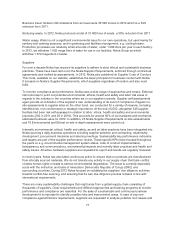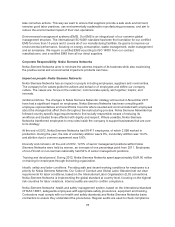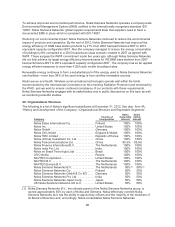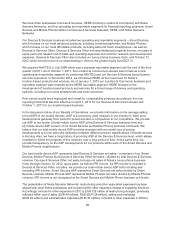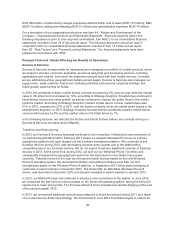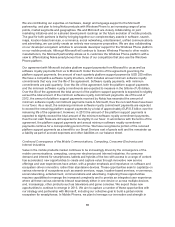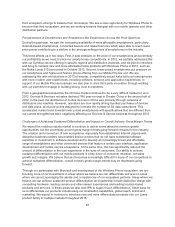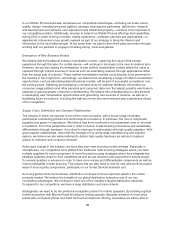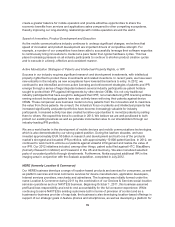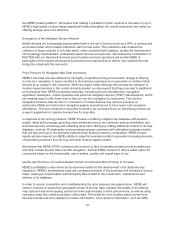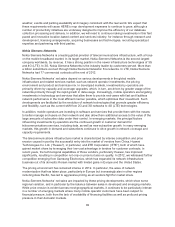Nokia 2012 Annual Report Download - page 87
Download and view the complete annual report
Please find page 87 of the 2012 Nokia annual report below. You can navigate through the pages in the report by either clicking on the pages listed below, or by using the keyword search tool below to find specific information within the annual report.growth markets to connect the next billion people to the Internet and information. We also plan to drive
third-party innovation through working with our partners to engage in building strong, local ecosystems
for our Mobile Phones devices.
Importance of Competing on an Ecosystem to Ecosystem Basis
The increasing importance of ecosystems is, to a large degree, driven by the convergence trends
mentioned above and the implications for the competencies and business model adjustments required
for longer-term success. In the market for smartphones, we have seen significant momentum and
emphasis on the creation and evolution of ecosystems around major software platforms, including
Apple’s iOS platform and Google’s Android platform, bringing together devices, software, applications
and services. As Android is available free of charge and a significant part of the source code is
available as open source software, entry and expansion in the smartphone market has become easier
for a number of hardware manufacturers that have chosen to leverage the Android ecosystem.
However, Samsung has emerged as a dominant participant in the Android ecosystem, making the
growth of other ecosystems increasingly more difficult and possibly raising the barriers to enter the
Android ecosystem with any compelling degree of profitability. Additionally, the success of an
ecosystem and its ability to continue to grow may depend on the support it lends to different kinds of
devices and, increasingly, other products such as televisions and game consoles. With multiple
products available to suit different needs, such as mobile devices, tablets, personal computers and
televisions, there is demand for greater seamless interaction among these devices. A number of
vendors across different ecosystems, including Apple, Google and Samsung, are pursuing multi-
screen strategies and building cloud technologies to capitalize on these opportunities.
Our partnership with Microsoft brings together complementary assets and competencies with the aim
of creating a competitive smartphone ecosystem. We believe that together with Microsoft we can
succeed in attracting the necessary elements for the creation of a successful ecosystem and that by
extending the price points, market segments and geographies of our Windows Phone smartphones, we
will be able to significantly strengthen the scale and attractiveness of that ecosystem to developers,
operators and partners.
In the low-end phone market, other ecosystems have emerged, including that based around Nokia’s
own Series 40 operating system which powers feature phones and our Asha full touch smartphones.
A growing number of developers are writing Java-based applications for Series 40 which are available
through the Nokia Store. Another ecosystem is the one which is based around mobile solutions
chipsets from low-cost reference design chipset manufacturers which have enabled the very rapid and
low-cost production of feature phones by numerous manufacturers especially in China and India, which
are making the business landscape more competitive, as well as bringing some locally relevant
innovations to market.
Increasing dominance by Apple and Samsung/Google’s Android platform in the smartphone market
During 2012, the ongoing trend in the smartphone market continued as Apple and Android further grew
their value market share driven by successful product launches. Apple and Samsung together captured
the majority of the smartphone market industry profits in 2012. These two entrenched ecosystems also
captured the vast majority of smartphone applications and services and through that much of the
industry profits made on applications and services. This also helps them attract third-party software
developers to their ecosystems. Also, hardware component suppliers and integrators find the leading
suppliers/ecosystems very attractive with their high volumes leading to better and more diverse
component supply availability. This increased dominance is making it increasingly more difficult for
other global ecosystem to emerge. However, due to the dominance of these two entrenched
ecosystems there is an increasing desire by mobile operators and other distribution partners to see a
86



